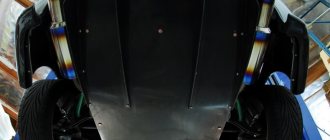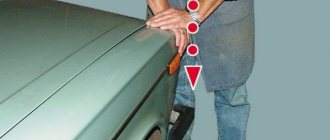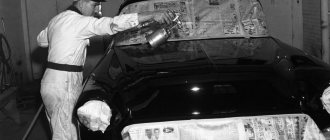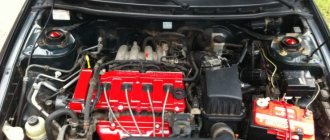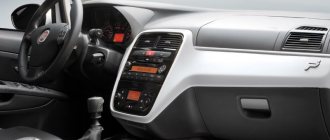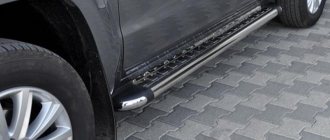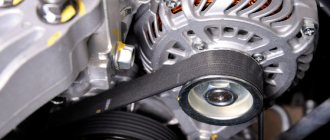A source of through corrosion, or simply a hole, in the bottom of the car is the price to pay for comfort in the cabin. Its primary source is not anti-icing reagents acting outside, but moisture accumulating under the “pie” of heat, sound and waterproofing. Therefore, when eliminating it, work is carried out mainly from the inside.
If you follow all safety rules when welding, you must completely dismantle the interior, including the trim. This is always very time consuming. Therefore, the question of how to seal the bottom of a car without welding is very relevant. Moreover, most alternative methods do not give worse, but rather better results.
Methods for restoring a car floor
Let's look at effective methods of how to repair a hole in the bottom of a car without welding for a long time.
Fiberglass and epoxy patch application
To fill the void in the bottom of the car with fiberglass material, you must:
Prepare the metal, remove rotten parts, treat with a converter. Clean the surface from traces of dirt and grease. Cut several pieces of fiberglass. The first should exceed the size of the hole by 25-35 mm, the second by 35-45 mm, the third by 55-65 mm. For larger holes, 4-5 pieces of material may be needed. The patching begins by soaking the first patch with epoxy glue. The piece is carefully placed on the hole, the edges are smoothed with a roller or brush. The remaining fiberglass fragments are glued one by one
It is important to saturate the material well with resin. This will prevent moisture from seeping between the layers and destroying the adhesion of the glue.
It is recommended to apply the following patches with a 45 degree rotation. After hardening, the fiberglass will evenly distribute the load due to the displaced layers.
The next patches are applied after the previous ones have set. Work is carried out outside and inside the salon. After final hardening, the fiberglass can be sanded and prepared for the application of primer, bitumen mastic or paint.
Method for filling holes using putty
There are special types of putties on the market that contain fiberglass. They are used to seal small defects. Fiber filler increases the strength of the putty and resistance to mechanical stress.
The process of patching a hole is similar to using epoxy glue. The composition is applied in small portions in several stages
It is important to wait until the previous layer has set - this will prevent the wet putty from sagging and loss of strength.
This method requires careful degreasing of the edges of the defect. In addition to rust removal procedures, it is necessary to thoroughly treat the area with anti-silicone compounds. Otherwise, the putty will not bond properly to the metal.
Does the DVR suction cup not stick to the glass? Let's glue it tightly!
Soldering a metal patch
Soldering is one of the effective methods for repairing a hole in the bottom of a car without welding. But household soldering irons are not suitable for heating metal - the area is too large. Portable gas burners are used. For convenient access to the defect site, use a remote gas supply through a hose.
Solder and flux are required for soldering. A low-melting filler with a high content of tin and lead is used as a soldering mixture. The flux used is acidic; if not available, battery electrolyte can be used.
Soldering has two disadvantages:
- Fire hazard. If safety precautions are observed, this point is leveled out.
- Tin-lead solder causes electrochemical corrosion of the metal in the joint area. To reduce this effect, you need to thoroughly heat the overlapped joint.
Installation of galvanizing and riveted connections
The technique of applying new sheets with rivets is popular among garage workers. The technology allows you to repair small and large-scale defects without resorting to chemical components and careful preparation.
First, the affected part of the bottom is removed. The edges of the cut are cleaned to a shine, paint, primer, and traces of sound insulation are removed. A new sheet of zinc steel is cut along the contour. The connection points of the patch with the bottom are marked, and holes are drilled to the diameter of the rivet. Note that the patch sheet is cut with a margin of 5-10 mm, depending on the damage.
The next step is to install the steel rivets. The operation is performed with a manual or pneumatic gun. The second option significantly speeds up the process and relieves the burden on the master’s hands. Upon completion of fastening, the joint is treated with bitumen sealant, and the sheet is primed and painted in color.
It is more difficult to install metal patches on curved areas of the floor. The repairman will need the ability to form the correct geometry from a straight galvanized sheet. In the area of power elements (spars, spacers, etc.), it is allowed to install bolts in these units. Together with rivets, they “tighten” the structure and increase the mechanical strength of the floor.
Methods for unscrewing bolts, screws or screws with licked heads
Using a soldering iron
There is another way to repair a hole in a car body without welding. A soldering iron is required here. First of all, we clean the area from rust. We make the patch from a sheet of metal (you don’t need to worry too much about this; an ordinary can of auto chemicals will do).
It is important that the patch is slightly larger than the holes and also completely covers them.
Additionally, you can coat the metal surface with anti-corrosion compounds - this will increase the quality of our repairs. Then we service the edges of the patch, after which, using a fairly powerful soldering iron, we solder it with a continuous seam.
Next, you should check whether it turns out that the patch protrudes somewhat above the body. If there is a protrusion, we eliminate this deformation with several gentle blows of the hammer. We remove various dents with putty (it is important that its layer reaches no more than 2-3 mm, otherwise the material will crack). Before filling, clean the surface with a metal brush.
In order for the putty to adhere well, it is important that abrasive marks (small scratches) appear on the patch.
The next step is primer. Here it is necessary to complete everything as quickly as possible to avoid the possibility of rust occurring in the future. It is best to first apply a thin layer of phosphate primer, and when it dries, another two or three layers of acrylic two-component composition (the interval between applications should be about 5-10 minutes). Everything dries in about 3-4 hours; if there is infrared heating, you can reduce the procedure to 20 minutes.
Application of fiberglass and glue
For moderate damage, the method of sealing holes with fiberglass is often used. When this area has been processed and cleared of layers of paint and rust, it is necessary to cut several overlays from fiberglass, the size of the hole plus 2 centimeters. This area should be pre-primed and allowed to harden.
Auto repair kit
An overlay is applied to the dry surface and secured with a mixture (polyester or epoxy resin + glue). The next “part” is applied and also fixed. Thus, all the fiberglass parts are glued, placing them one on top of the other. To prevent them from sagging or deforming, you should put a lining. When the resin and glue have dried, you need to treat the work area and paint it.
Fiberglass
Application of fiberglass and glue
For moderate damage, the method of sealing holes with fiberglass is often used. When this area has been processed and cleared of layers of paint and rust, it is necessary to cut several overlays from fiberglass, the size of the hole plus 2 centimeters. This area should be pre-primed and allowed to harden.
Auto repair kit
An overlay is applied to the dry surface and secured with a mixture (polyester or epoxy resin + glue). The next “part” is applied and also fixed. Thus, all the fiberglass parts are glued, placing them one on top of the other. To prevent them from sagging or deforming, you should put a lining. When the resin and glue have dried, you need to treat the work area and paint it.
Fiberglass
What are the defects?
Depending on the degree and type of damage, the repair method is selected. Without welding, it is possible to restore a part in the following cases:
- Dent of a non-removable element, bend of the lower edge. If the dent is shallow and without a sharp edge, then the drawing method, back hammering, and straightening are used.
- A chip in the paintwork with a small area of corrosion. Anti-corrosion metal treatment, stripping, and grinding are used.
- Point-through corrosion can be repaired with epoxy resins and fiberglass patches.
Do-it-yourself repair of rotten thresholds is carried out only by welding. It is necessary to cut out or knock out the rusted metal, weld a patch or a new part of the structure.
Removable elements are repaired only with minimal damage: dents, scratches, chipped paintwork. In case of serious defects, the part is replaced with a new one; the cost of the analog and repair costs are almost the same.
Installation of galvanizing and riveted connections
Processing holes in the bottom of a car with galvanized metal is quite common. The main material required for this is iron sheet. Before installation, it should be secured with self-tapping screws and lubricated with mastic. It is best to use an anti-noise bitumen mixture. The galvanized sheeting is then laid and bolted in place using a drill. Then you need to treat the area with special means and level the entire surface. When everything dries and the structure is fixed, it should be coated with paint.
Decoding the symbols on the buttons and connectors of the radio
https://youtube.com/watch?v=xug-dOUT16E
Another reliable option for filling holes is to make rivet joints. Using this technology, large and small holes can be eliminated. To do this, the damaged area is cut out and the edges are cleaned of paint and rust. Next, steel rivets are cut out, since they are least susceptible to corrosion. Then the part is applied and secured with these rivets. When the structure is completed, the entire area is painted.
Pneumatic riveter
So, there are several ways to repair holes in the bottom of a car without welding. You can use any method described in this article. Choose exactly the option that you can implement. And remember, it is possible and very pleasant to carry out any task on your own.
Soldering a metal patch
Soldering a metal element to a damaged area is a way to seal holes in the bottom or any other part of a car when you can close a small hole. To repair a machine using this technology, you must have the following tools:
- a piece of metal sheet;
- powerful soldering iron;
- flux or rust converter;
- putty;
- primer.
Materials in the car
So, first, the area that needs to be repaired is cleaned, paint, rust, and dirt are removed. Next, it is treated with flux and degreased. Then measurements are taken and a metal piece of the desired shape is cut out. Such an element will completely seal the hole, and the edges will overlap. When the part for the patch is ready, it is attached with a soldering iron. Then the edges of the patch are treated with flux. Finally, it is worth treating the area with putty and priming it. When the surface is dry, paint and a protective layer are applied.
This method of filling holes in the bottom of a car is the most popular. Experts note the durability of the soldered patches, since the connection is quite reliable. In addition, this method can be used to seal a hole of any size. In general, soldering a patch is quite simple, and even a beginner who does not have much experience in car repairs can handle it.
Sequence of actions when sealing holes in the bottom
How to repair through holes on a car body using putty without welding
Before repairing a hole in the car body, you should prepare:
- fiberglass and automotive putty;
- aluminum mesh;
- putty knife;
- sandpaper (if possible, it’s also worth looking for a sanding machine);
- primer, paint, varnish.
Fixing holes in a car body itself is distinguished by its simplicity. First of all, you should remove the rust using an angle grinder or any other suitable equipment. Next, we cut out the patch from aluminum, and then attach it to the body using masking tape. We apply a thin layer of fiberglass putty (here it is important not to touch the tape, because then you will have to remove it). When the putty sticks, peel off the tape and putty the remaining areas.
It is important that the layer is as thin as possible, without tubercles or other irregularities.
When everything is dry, sand everything using coarse sandpaper or a sander.
Having achieved a flat and smooth surface, apply a second ball of putty - automotive putty. We wait until it dries and level it again. Then the surface is primed (do not forget to cover the areas that do not require painting with film). When the primer is finished, you can paint the body.
It is worth noting that the patch will be more stable if you apply a couple of layers of putty on the back side. In addition, it is also possible to seal holes in the car body without welding using putty and without using a patch. In this case, it is necessary to apply a lining on the back side so that the composition is well fixed. On the other hand, this solution is only suitable for very small through holes.
Let's watch a detailed video on how to seal holes without welding:
Work technology
The rivet connection method is the fastening of two or more metal sheets using cylindrical rods with heads at the ends. Holes are pre-drilled in the parts to be joined. A rivet, with one head made in advance, is inserted into the hole and the second head is formed. The heads of the rivets pull the sheets together and prevent them from being torn off. The rod of this fastener prevents the lateral mutual displacement of parts and is subject to shearing forces.
Rivet joints are used in body production:
- for securing sheets (of light alloys most often);
- for securing parts made of plastic materials;
- when assembling frames.
During repairs, this method is most often used to replace corroded body cladding when welding is unreliable. Riveted joints are especially common when repairing floors - the damaged area is replaced with a new panel. A properly executed rivet seam is as strong as a welded seam.
Cold methods of sealing holes in metal
There are two ways to repair holes in the underbody of a car without using hot work.
- Using composite materials - various types of polymer resins in combination with a reinforcing filler and a curing reaction accelerator. With high-quality surface treatment, in addition to restoring mechanical strength, they play the role of inhibitors - retarders of chemical and electrochemical corrosion reactions;
- Installing sheet material patches onto rivets.
General technological rules
Holes in the bottom are usually discovered from the outside, when inspecting the car on a pit or lift. Signs of through corrosion are local swellings, which, when you try to pick them out, crumble into dust.
If you find such troubles, you need to open and remove the pie of heat, noise and waterproofing on the floor in the cabin in the entire area where the sheet of iron forming the floor is welded to the power elements of the body - thresholds, tunnel and others. Then you will see the whole picture of the damage and will be able to take preventive measures in those places where corrosion has not yet become through.
Hole in the bottom of the car
Before the actual process of sealing the holes, you need to take measures to slow down the corrosion process (stopping it is an unattainable ideal to strive for). To do this, all rags of iron are removed, and the edges that have residual strength are treated with sandpaper and a wire brush until shiny. The cleaned surface is treated with rust converters. For example, the “Tsinkar” composition. Work is being carried out inside and outside.
The work makes sense if the total surface of through holes does not exceed 15% of the floor area.
Fixing pinholes
If the source of through corrosion has a diameter of no more than 1 centimeter, it can simply be covered with a two-component polymer composition. Poxipol glue or a cold welding kit similar to plasticine gives good results.
A small hole makes it possible to use so-called cathodic electrochemical protection. Find an aluminum rod, make a rivet out of it and fill the hole with it. Within a radius of 20 cm from it, corrosion will stop. True, the rivet will gradually collapse on its own. But this may take five years.
Repairing large-scale damage
In this case, you will have to take care to restore mechanical strength. If the hole is on a flat area, then there is no point in messing around with epoxy and fiberglass.
A truly durable composite material is obtained only with absolutely precise adherence to technology - mixing proportions, drying mode and much more. Use ready-made material of this kind, for example, textolite. Having a thickness of 3 mm, it is not inferior in strength to sheet iron. The plate can only be installed with epoxy glue, but it is better to use a combined connection using rivets. The latter should be made of aluminum, then they will play the role of cathodic protection.
Patches on the bottom of the car
Long holes at the joints with power elements are eliminated with patches made of sheet iron or aluminum. They need to be bent according to the shape of the joint so that the width of the contact zone with the still living material is at least 2 cm. They are installed on aluminum rivets; the use of an epoxy compound would be useful. Especially if sheet metal is used. After all, you cannot know exactly its composition and in which direction electrochemical corrosion will go - whether it will destroy the patch or the body. The polymer resin will act as an inhibitor.
Restoration methods
There are more than ten ways to repair car thresholds with your own hands without welding. With the advent of new samples of glue, resins, protective fibers and equipment, the number of methods is increasing. The most common, simple ones for garage repairs:
- fiberglass treatment;
- epoxy glue;
- construction foam;
- hood without painting;
The use of a reverse hammer, as well as a spotter, are both spot welding repair methods.
fiberglass
Repair using fiberglass or fiberglass is quite simple, cheap, but reliable. Advantages:
- does not interact with reagents on the roads - water, acids, electrolyte;
- has little weight;
- easy to use;
- used for a long time;
- has a low price.
As an alternative, fiberglass or fiberglass is used. The method is used if there are pronounced pockets of corrosion on the metal, without impact deformation. Epoxy glue or resin is used together with the material.
For repairs you will need sandpaper, hardener, brushes, spatulas of different sizes. As a substitute for epoxy glue, you can use polyester resin, which is similar in properties, but somewhat inferior to epoxy in strength. To complete the surface sealing you need:
- Use a grinder to remove the paint layer.
- Sand it with sandpaper.
- Cut a patch from the fiberglass larger than the corrosion area.
- Degrease and prime the surface.
- Glue the patch with putty or epoxy glue.
- Fill the surface and prime it.
- Treat with anti-gravel compound.
- Paint it.
Epoxy glue
A common epoxy adhesive is the ED-20 brand; as a rule, it comes complete with PEPA hardener. These components are mixed in a ratio of 1:10. When working with epoxy glue, you must take precautions, protect your eyes and hands. Contact with chemically active substances can cause severe irritation of the skin and mucous surfaces of the eyes, which can cause allergies.
The repair procedure is similar to using fiberglass. If the deformation is minor, it is permissible not to use reinforced mesh. The glue is applied to the damaged area in several layers, puttyed, primed and painted.
Construction foam
Manufacturers of Japanese vehicles often use special foam, which is used to fill the permanent threshold box during factory assembly of the car. It is believed that the material will ensure that there is no corrosion inside the threshold and will preserve the parameters of the seal. The sealant is anti-corrosion resins and mastics, polyester components, which have nothing in common with construction foam.
Repair of the VAZ-2110 underbody without welding
With any body repair, first of all, it is necessary to carry out an external inspection of the hardware, identify and note for yourself which areas are in poor condition and need repair or replacement. The condition of the bottom metal is determined in different ways:
- using a hammer and a core - if you think that there is rust in a certain area, you need to lightly hit the metal, check if there is rotten iron under the anti-corrosion coating;
- try to jack up the car on each side - if the thrust pads are rotten, this will be noticeable when you try to jack up the car;
- press in different places on the floor of the car - weak, rotten iron will bend under your feet;
- try to move the front seats back and forth in the cabin - problematic movement of the seats also often indicates the poor condition of the metal.
Any repair of sills and underbody using a non-welding method is not professional, and craftsmen consider it only a temporary measure to properly restore the condition of the body; a welding machine is indispensable. When repairing the bottom without welding, patches and new body elements are not welded, but installed on rivets or self-tapping screws (bolts), preparation and all other work is carried out in the same way as during traditional body repair using a welding machine.
Repair of large-scale damage
If the bottom of the car is rotten over a large area, then it is necessary to restore the strength elements of the floor and restore strength. In addition to metal, composite materials are often used - textolite and other combinations. The method of performing the work is similar to applying galvanized patches. If the affected area is flat, there is no need for epoxy adhesives. Standard rivets and self-tapping screws will do.
It is worth remembering: if the area of the affected bottom exceeds 60-65% of the total size of the machine floor, restoration work is considered ineffective. A complete replacement of a part from a similar car using a welding machine will be required.
Types of rivets
Made from malleable metals. The most common are rivets made of aluminum and its light alloys, mild steel, brass, copper and others. There are types:
- simple;
- special.
Simple ones have a solid core. The factory head can be cylindrical, round or countersunk (flat). These fasteners are used when there is good access to both surfaces of the sheets being fastened, because a pneumatic or hand hammer is used to form the second head.
Special rivets have a tubular rod and the factory head has a hole in the center. The second cap is obtained by pulling and then tearing off the mandrel (rod with a thickened end). The result is a head in the form of a thick shoulder. The second method is to push the cylindrical rod, as a result of which the inner shoulder expands and transforms into an outer one. Special ones are used in cases:
- the back surface of the joined sheets is inaccessible or difficult to access;
- for bonding metal to laminated plastic parts;
- for fastening decorative parts.
Method for filling holes using putty
In the area of the hole in the bottom, the damaged coating, that is, the old layer of paint, should be removed, the metal should be cleaned, and treated with a special preparation - a rust converter. Then the working surface is degreased and primed. Next, prepare a putty solution of uniform consistency. For greater efficiency, fiberglass is added to it (most often with large elements). Then the composition is carefully applied to the damaged area. This is perhaps the most important part of the job. It is necessary to seal all the holes, cracks and microcracks that may arise around it. Application of the solution should occur in several stages, allowing each new layer to dry.
Sealing with putty
To achieve maximum fixation of the putty on the damaged area, a backing is applied to the reverse side. It does not allow the solution to spread, but acts in the area that needs to be repaired. If the hole in the bottom of the car is large enough, this repair method can also be used with auxiliary elements. Instead of a lining, a metal mesh is installed in the damaged area. Therefore, the putty is evenly distributed over it, filling the entire space. After the solution has completely dried, this area is treated with automotive paint putty. Then the damaged area is painted and a protective film is applied.
Putty for cars
Other solutions
Recently, it has been possible to close the holes in other ways. One of them involves working with fiberglass.
- The surface of the body is also cleaned and degreased, as in the two cases described above.
- Overlays are cut out of fiberglass, the size of which should be 2 cm larger than the hole size.
- The area is pre-primed and the composition is given time to harden.
- The pad is applied to a completely dry surface.
- Fiberglass linings are fixed using an adhesive-resin composition.
First, one overlay is glued, then the second, third, and so on. Again, it is recommended to put a lining on the reverse side.
After the glue has dried, the body surface is treated and painted.
As you can see, holes on the car body caused by corrosion can be easily eliminated with your own hands. Visual examples can be seen in the video and photo.
Forget about fines from cameras! An absolutely legal new product - Traffic Police Camera Jammer, hides your license plates from the cameras that are installed in all cities. More details at the link.
- Absolutely legal (Article 12.2);
- Hides from photo and video recording;
- Suitable for all cars;
- Works through the cigarette lighter connector;
- Does not cause interference to radios and cell phones.
If you decide to start painting your vehicle, it is likely that you will be faced with through holes in the body that have arisen as a result of exposure to rust. It is worth noting that body repairs are quite expensive, so not every car enthusiast wants to turn to professionals.
As a result, many are interested in how to repair holes in a car body without welding with their own hands. This is exactly what we will talk about now.
Rivet seam
Regardless of the type, when repairing, it is necessary to use rivets of the same material as the sheets being fastened. Aluminum fasteners will gradually deteriorate if they are used to rivet brass, copper, corrosion-resistant or ordinary steel. In a more humid atmosphere, this process will be more noticeable, since electrolytic pairs are formed.
Important parameters of rivet fastening are the distances from the edge of the sheet to the center of the rivets and the pitch size (the distance between the axial axes of adjacent fastening elements mounted along the same line - the seam). The pitch size is a multiple of the fastener diameter and depends on the purpose of the riveted part. For the example above, with a diameter of 4 mm, the length of the riveting rod is 8 mm. The step size is 40 mm. From the edge of the sheet to the axis of the seam - 8 mm. In some cases, when repairing a body, they focus on the spot welding step and mark the installation of fasteners using it.
Installation procedure for simple rivets:
- The sheets are fastened with bolts through 5 - 6 holes drilled for rivets. Mismatched holes are processed by re-drilling or by reaming.
- The fastener is installed with the head to a thinner sheet.
- The head of the fastener is mounted on a massive anvil. Use a riveting stand for round heads - this will protect the head from deformation.
- A mandrel is placed on the riveting rod and struck several times with a hammer. The sheets should be pressed towards the cap.
- The upsetting mandrel is removed and blows are made along the axis of the fastener rod. As a result, the fastening element, crumpling, first fills the hole and then forms a blank for the closing head.
- The edges of the stave are struck at an angle, forming a head.
- A riveting mandrel is installed on the head and the formation is completed. When riveting fasteners with countersunk heads, as a result of flattening with a hammer, the metal crumples and fills the countersink.
- The mounting bolts are removed and fasteners are installed in their place.
Installation of special rivets:
- Item 1 for simple fastening elements.
- The rivet is inserted into the hole, and a rolling rod is inserted into the broaching device.
- The head is pressed forcefully against the sheets, which are pressed together.
- The tensioning device is activated until the fastener rod comes off.
- P.8 for simple ones.
Application for riveting the piercing rod:
- In most cases, the piercing rod is driven in with a hammer. During operation, it is necessary to control the tightness of the sheets adhering to each other, applying force near the riveting head.
- The head is pressed against the sheets under the action of advancing the piercing rod (it is struck with a hammer).
For mechanical installation of simple rivets, a pneumatic hammer is used. Short successive blows lead to the formation of the head. When using fasteners made of aluminum and light alloys, pneumatic guns are used to form the head in 1 blow. Special rivets are installed mechanically if the rolling rod is of the pulling type.
Defects during riveting:
- occurrence of simple rivets;
- a thickening forms between the sheets - as a result, the size of the head decreases;
- poor flaring of special fastener elements is a consequence of insufficient length;
- the mobility of the rivet in the hole is a consequence of the large gap between the hole and the inserted fastener, which does not extend enough to fill the gap.
Drilling holes for rivets
The hole is drilled with a diameter slightly larger than that of the riveting rod. However, you should strive to obtain the smallest gap, since in this case:
- simple fastening elements have less bending potential;
- special ones roll better.
In practice, during repairs, the diameter of the hole is determined by the size of the available drills. For small diameter rivets used in tinsmithing, the total clearance should be within 0.5 mm. If possible, the hole should be processed - remove burrs from the inner surface that were formed during drilling.
Before drilling the sheets, select the length and diameter of the rivets. For example, for mounting a 1.0 mm sheet on the floor of a body with a metal thickness of 0.6 mm, the diameter of the fastening element will be approximately 4.0 mm. If special rivets are used, the sheets being joined may be thicker than is acceptable for simple ones. This applies if the fastening elements are subject to low forces. Body trim sheets are subject to vibration loads, torsional and bending stresses that arise when the vehicle moves on an uneven road. They make the fastener “play.” Since in the case of large forces it is necessary to take the diameter of the fastening element larger than the calculated one, then for the above example the diameter will be 5.0 mm.
The length of the rivets is selected depending on their type. In simple ones, it is determined by the length of the rod. Therefore, the length of the fastening element is calculated as the sum of the thicknesses of the parts being connected and the thickness of the metal required to fill the gap between the hole and the riveting and to form the head. When forming a round closing head, a rod length equal to 1.5 times the diameter is added to the total thickness of the sheets. To determine the dimensions of special fasteners, use tables supplied by manufacturers.
Fixing pinholes
When diagnosing a car, if there is a pinhole from corrosion on the threshold, in 80% of cases it is necessary not only to repair the hole, but also to change the amplifier. A full inspection will reveal large areas of rusty metal under a layer of paintwork. If a pinhole occurs from mechanical damage, then it is not associated with natural wear of the metal, so small holes are sealed using putty or soldering.
Soldering is carried out according to the same algorithm as sealing a hole with a sheet of metal, the only exceptions being the small size of the patch.
Use of soldering
If small holes in the threshold or bottom of the car are sealed with soldering, then simple tips will help:
- For heating metal more than 0.5 mm thick, household soldering irons are of little use. It is better to use a portable gas burner that has a small cylinder from 400 to 700 ml. The work will go faster.
- To solder thresholds you need solder and flux. For solder, a composition with lead or tin is used; the flux can be replaced with electrolytic acid.
Experts recommend not using soldering for body work at all. The main reason is that solder, tin or lead have a much lower electrical potential than iron; during their contact, electrochemical corrosion occurs, which can subsequently lead to full-fledged rust at the joints.
The second disadvantage of soldering is hot work, which is carried out in a safe place and as carefully as possible.
General technological rules
A sign of the active process of metal decay is the formation of local bubbles. You can find them on an inspection hole or lift. When you try to tap a hole, its edges begin to crumble into small pieces. This is a clear sign of impending renovation.
If a defect is detected, it is necessary to open the layer of insulating material in the interior. The area of the “pie” to be removed should be one and a half to two times larger than the most problematic area. This is due to the fact that the hole needs to be cleaned further than the edges. Ideally, it is recommended to remove the trim and seat where repairs are to be carried out. This way you can evaluate the entire picture of damage and localize new areas of corrosion.
Corrosion is like a fungus; it spreads over the entire area of the metal. To do this, rotten pieces are removed, the surface is cleaned until a shiny layer appears. In practice, cleaning can go far from the main focus. Example: a hole of 1-2 cm requires grinding up to 15-20 cm around the perimeter.
After restoring an entire layer of metal, it is necessary to treat its structure with corrosion inhibitors - converters. Treatment is carried out inside and outside.
How to stretch a threshold without welding
Repairing a threshold after a dent involves using a reverse hammer, a suction cup, or cutting the area of deformation for a non-removable element. The algorithm of action is as follows: it is necessary to drill holes with a diameter of 1-2 mm near the dent, insert special metal corner hooks of a reverse hammer into them. Then tapping on yourself straightens the area of deformation.
You can weld by spot welding, placing the end of a hammer on the dent, and drawing out the metal. In this case, you need to start from the corner of the dent, welding the end every 3-5 mm, while straightening the surface with a hammer.
The most reliable way to stretch the threshold without full welding is to use a spotter, rings, or stop. The method is often used at service stations, since many drivers do not have the necessary tools in the garage. You can make the device yourself from a used microwave oven. Drawing process step by step:
- The negative terminal from the battery is disconnected.
- Using a sanding machine, a layer of old paint is removed from the entire surface of the dent.
- Spot welding is used to install rings through which the puller bar is passed, and the metal is drawn out using a stop. The procedure is repeated until the surface becomes as smooth as possible.
- The metal is sanded with emery, treated with a degreaser, and primed.
- A thin layer of automotive putty is applied and treated with anticorrosive.
- After complete drying, it is painted with enamel.
Another way is to use a vacuum suction cup. This approach allows you to preserve the paintwork. The difficulty of using suction cups is due to the uneven edge of the dent; it is quite difficult to use a vacuum even if the dent has sharp edges and metal creases.
A frequent question about how to repair rotten sills on a car has only one answer: nothing. Rotten parts must be knocked out or cut out, the seal checked, and new metal welded. Cosmetic repairs are used only before urgently selling a car, but this is just one way of deceiving a gullible driver; it has nothing to do with a full restoration.
It must be remembered that thresholds are called rotten if metal corrosion exceeds 65-70% and there are through holes.
With minimal foci of primary corrosion, the elements are ground, treated with putty, and primed. To strengthen the structure, plastic or aluminum overlays are used.
Method for filling holes using putty
In the area of the hole in the bottom, the damaged coating, that is, the old layer of paint, should be removed, the metal should be cleaned, and treated with a special preparation - a rust converter. Then the working surface is degreased and primed. Next, prepare a putty solution of uniform consistency. For greater efficiency, fiberglass is added to it (most often with large elements). Then the composition is carefully applied to the damaged area. This is perhaps the most important part of the job. It is necessary to seal all the holes, cracks and microcracks that may arise around it. Application of the solution should occur in several stages, allowing each new layer to dry.
To achieve maximum fixation of the putty on the damaged area, a backing is applied to the reverse side. It does not allow the solution to spread, but acts in the area that needs to be repaired. If the hole in the bottom of the car is large enough, this repair method can also be used with auxiliary elements. Instead of a lining, a metal mesh is installed in the damaged area. Therefore, the putty is evenly distributed over it, filling the entire space. After the solution has completely dried, this area is treated with automotive paint putty. Then the damaged area is painted and a protective film is applied.
Putty for cars
Filling holes in the body with putty
As a rule, holes most often appear on the bottom of the car. And in this case, everything around is thoroughly cleaned, car cosmetics (rust converter) and many other kits are used. Degreasing and priming are also required.
The technology of direct application of putty, without the use of a patch, involves application from the back side of the lining area. In this way, it will be possible to significantly achieve maximum fixation of the composition. You can use a metal mesh instead of a lining as such. These are even sold in stores, you can make them yourself, etc.
The putty must be evenly distributed over the surface, filling the entire space of the hole. After the solution has dried, the area is treated with painting putty. Then, after drying, they paint and put on a protective film.
This option for eliminating a through hole in the body is the simplest. Experts, however, do not recommend using it, since the putty will begin to leak moisture over time and will collapse. This method is most suitable if restoration is urgently needed and there are no other alternatives.
Weldless auto repair options
Car body repairs without welding are considered unprofessional, since this is not the product of numerous scientific research. There are several ways.
General requirements: the damaged area is removed with a grinder or chisel. Anticorrosive and zinc are applied and degreased. Next, the holes are sealed with paint putty, creating a surface of a suitable shape, and painted.
Puttying a car
The material used is fiberglass with the structure:
- small;
- average;
- large.
The coarse fiber composition is suitable for repairing minor damage. Applicable when they are located near structural pockets. The composition of the lining is fixed, placed on the inside. Puttying is a budget option, but it is not very reliable.
A layer of putty is applied to the cleaned, primed metal surface. First inside, then the surface is worked. After the starting layer has hardened, the second layer comes on. Drying is done at room temperature.
The use of aluminum/brass mesh makes it possible to repair significant damage. The hole is covered with a mesh and secured with tape. After puttying and processing, the tape is removed.
Fiberglass + synthetic glue
Large damages are repaired with fiberglass. The adhesive is epoxy or polyester resin. Fiberglass fabric is applied in several layers, each overlapping the previous one by 2 cm.
Everything is coated with adhesive. Fabric sagging is eliminated by installing linings. Drying is in progress. This option is suitable for minor damage.
Soldering
A method for removing significant body damage. The metal patch is pressed against the body and connected with solder. Flux will give strength. Solder and flux are selected based on metal alloys. They work with a high-power electric soldering iron.
Negative points:
- high cost of solder;
- low strength.
The metal patch should cover the hole without a gap. The initial stage is tinning the surface. The protruding overlay is hammered down. Next - puttying and painting.
Rivets
Option for repairing large damaged areas and replacing parts. The method is preferable to welding when repairing the bottom. The damaged area is removed and a new piece of metal or part is placed. They are riveted with steel rivets, diameter - 5 mm, for load-bearing elements - 6 mm.
Before placement, the rivets are treated with an anti-corrosion substance. A riveter is required.
Other methods
The bottom is repaired with galvanized sheets using bolted connections. The damaged area is removed with an angle grinder. Cut out 2 pieces of galvanized metal - for the top and bottom. The floor is coated with bitumen mastic on both sides. Galvanization is also processed.
Mount the lower component, securing it with self-tapping screws. Long ends are removed. Install the upper component. Fastened with M5 bolts. The fasteners go along the perimeter to avoid bending of the sheets.
Repair of box-shaped body elements without welding equipment is carried out by drilling holes. Then the tool is inserted and the fault is corrected. The hole is sealed using any of the above methods.
Car body repair without welding: do-it-yourself repair, video
Watch this video on YouTube
Repair by sealing the hole with metal
Metal patches and subsequent soldering are considered the most productive means for restoring thresholds, even with a large area of corrosion. If rust has not led to deformation of the central pillars and distortion of the geometry, then you can use metal patches and strengthen them with a soldering iron. For repairs you will need the following materials and tools:
- metal patch, size 2 cm larger than the corrosion hole.
- assembly hammer;
- Bulgarian;
- medium abrasive sandpaper;
- anti-gravel;
- anti-rust composition - phosphoric acid, if available;
- soldering iron, tin solder;
- automotive primer, degreaser.
Rivet seam
Regardless of the type, when repairing, it is necessary to use rivets of the same material as the sheets being fastened. Aluminum fasteners will gradually deteriorate if they are used to rivet brass, copper, corrosion-resistant or ordinary steel. In a more humid atmosphere, this process will be more noticeable, since electrolytic pairs are formed.
Important parameters of rivet fastening are the distances from the edge of the sheet to the center of the rivets and the pitch size (the distance between the axial axes of adjacent fastening elements mounted along the same line - the seam). The pitch size is a multiple of the fastener diameter and depends on the purpose of the riveted part. For the example above, with a diameter of 4 mm, the length of the riveting rod is 8 mm. The step size is 40 mm. From the edge of the sheet to the axis of the seam - 8 mm. In some cases, when repairing a body, they focus on the spot welding step and mark the installation of fasteners using it.
Installation procedure for simple rivets:
- The sheets are fastened with bolts through 5 - 6 holes drilled for rivets. Mismatched holes are processed by re-drilling or by reaming.
- The fastener is installed with the head to a thinner sheet.
- The head of the fastener is mounted on a massive anvil. Use a riveting stand for round heads - this will protect the head from deformation.
- A mandrel is placed on the riveting rod and struck several times with a hammer. The sheets should be pressed towards the cap.
- The upsetting mandrel is removed and blows are made along the axis of the fastener rod. As a result, the fastening element, crumpling, first fills the hole and then forms a blank for the closing head.
- The edges of the stave are struck at an angle, forming a head.
- A riveting mandrel is installed on the head and the formation is completed. When riveting fasteners with countersunk heads, as a result of flattening with a hammer, the metal crumples and fills the countersink.
- The mounting bolts are removed and fasteners are installed in their place.
Installation of special rivets:
- Item 1 for simple fastening elements.
- The rivet is inserted into the hole, and a rolling rod is inserted into the broaching device.
- The head is pressed forcefully against the sheets, which are pressed together.
- The tensioning device is activated until the fastener rod comes off.
- P.8 for simple ones.
Application for riveting the piercing rod:
- In most cases, the piercing rod is driven in with a hammer. During operation, it is necessary to control the tightness of the sheets adhering to each other, applying force near the riveting head.
- The head is pressed against the sheets under the action of advancing the piercing rod (it is struck with a hammer).
For mechanical installation of simple rivets, a pneumatic hammer is used. Short successive blows lead to the formation of the head. When using fasteners made of aluminum and light alloys, pneumatic guns are used to form the head in 1 blow. Special rivets are installed mechanically if the rolling rod is of the pulling type.
Defects during riveting:
- occurrence of simple rivets;
- a thickening forms between the sheets - as a result, the size of the head decreases;
- poor flaring of special fastener elements is a consequence of insufficient length;
- the mobility of the rivet in the hole is a consequence of the large gap between the hole and the inserted fastener, which does not extend enough to fill the gap.
Soldering a metal patch
Soldering a metal element to a damaged area is a way to seal holes in the bottom or any other part of a car when you can close a small hole. To repair a machine using this technology, you must have the following tools:
- a piece of metal sheet;
- powerful soldering iron;
- flux or rust converter;
- putty;
- primer.
Materials in the car
So, first, the area that needs to be repaired is cleaned, paint, rust, and dirt are removed. Next, it is treated with flux and degreased. Then measurements are taken and a metal piece of the desired shape is cut out. Such an element will completely seal the hole, and the edges will overlap. When the part for the patch is ready, it is attached with a soldering iron. Then the edges of the patch are treated with flux. Finally, it is worth treating the area with putty and priming it. When the surface is dry, paint and a protective layer are applied.
This method of filling holes in the bottom of a car is the most popular. Experts note the durability of the soldered patches, since the connection is quite reliable. In addition, this method can be used to seal a hole of any size. In general, soldering a patch is quite simple, and even a beginner who does not have much experience in car repairs can handle it.
Sequence of actions when sealing holes in the bottom
Algorithm for carrying out the process of eliminating a through hole by applying a patch with a soldering iron
Here's what to do:
- To begin with, it is recommended to thoroughly clean the rust from the corrosive area. You can use attachments and a drill (also another set of tools).
- A patch is cut from a piece of metal sheet. An option is to use a can of auto chemicals, etc.
The patch must cover the entire hole on the vehicle frame element.
- A powerful soldering iron is prepared, with which the patch is applied.
It is also recommended to use anti-rust compounds, otherwise called orthophoric acid. Another help will be the use of tin solder.
- Now you need to tin the edges of the patch.
